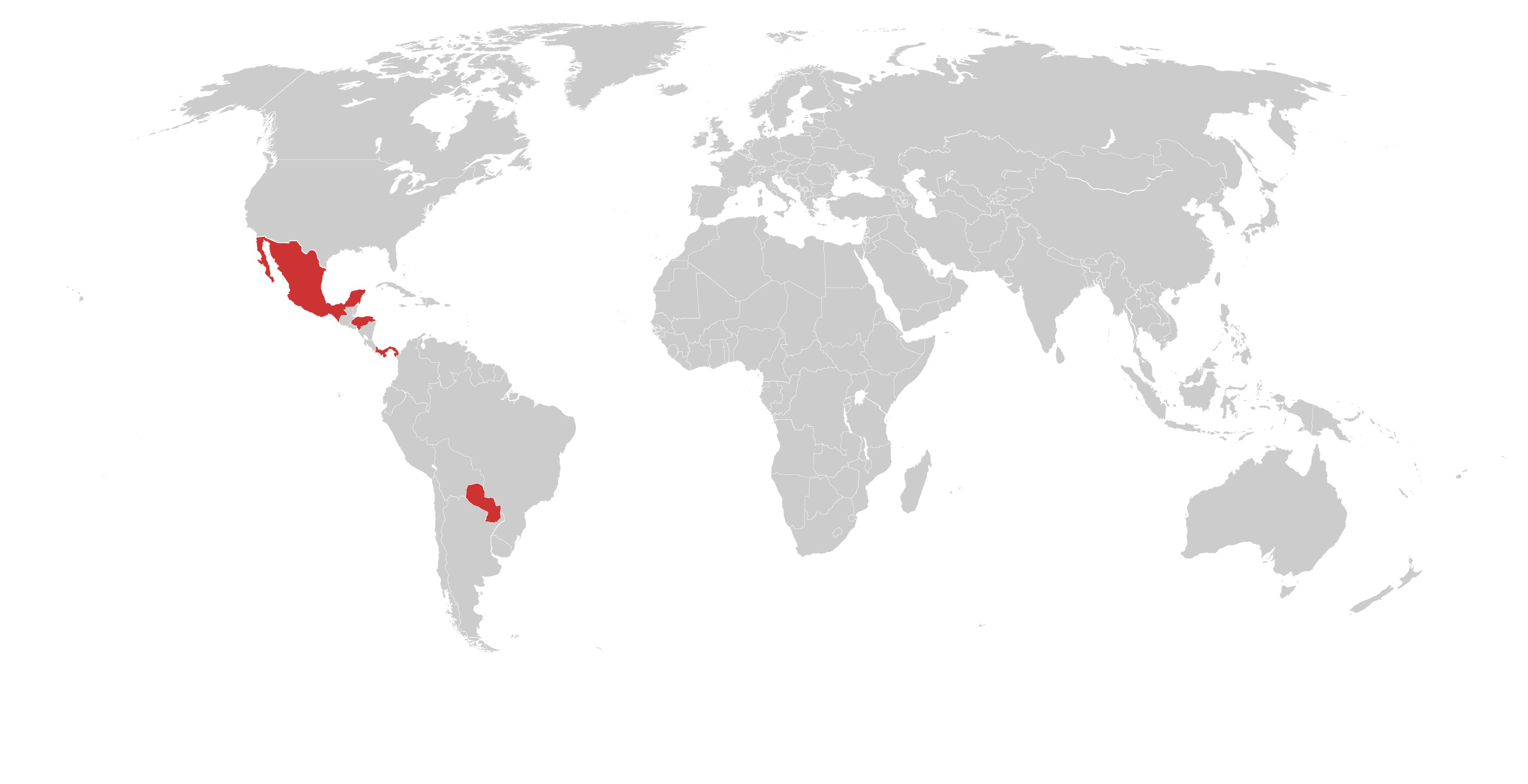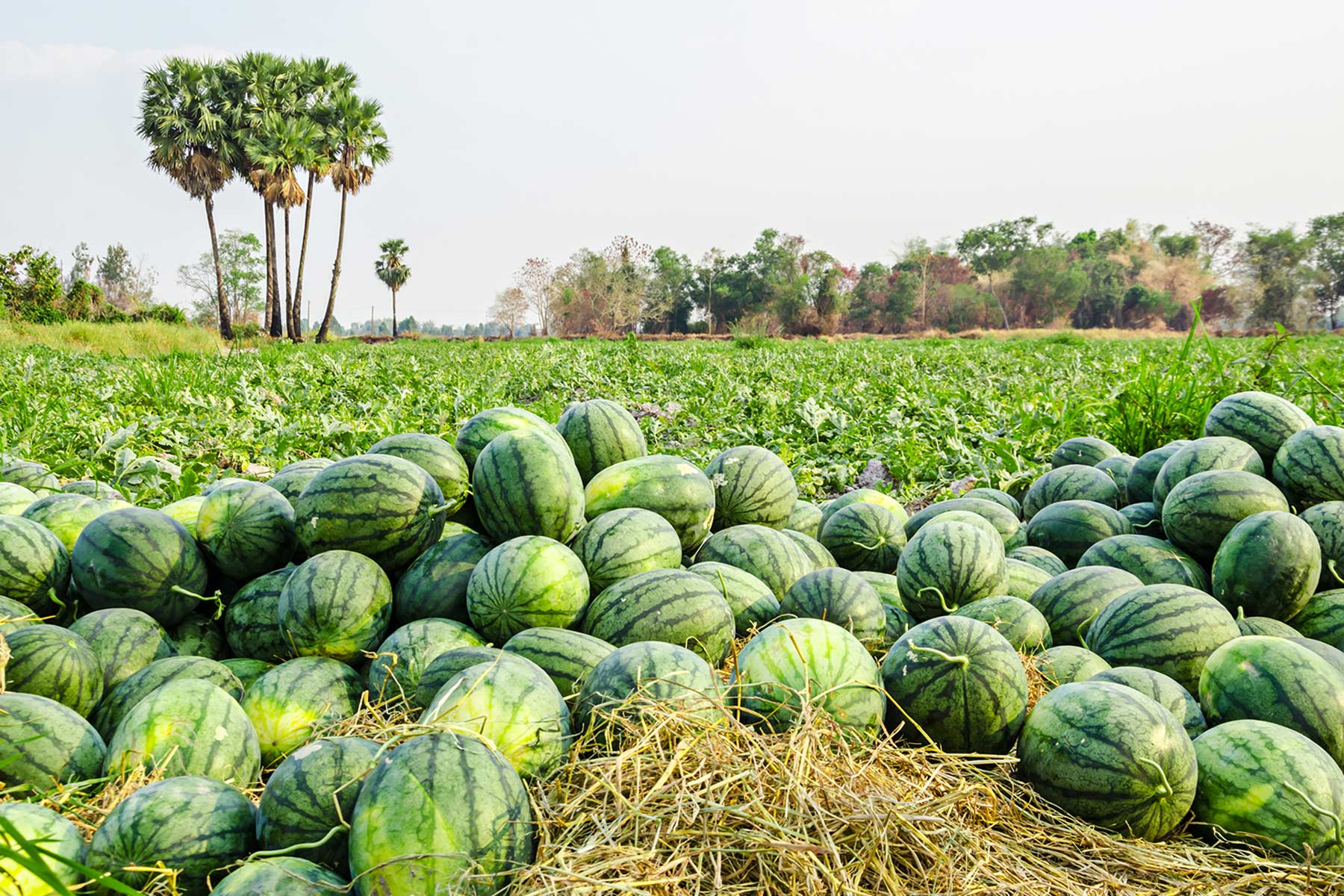Commodity Atlas
Melon
Countries Where Melon is Reportedly Produced with Forced Labor and/or Child Labor
Melons are reportedly produced with forced labor (FL) and/or child labor (CL) in the following countries:
Honduras (CL)
Mexico (CL)
Panama (CL)
Paraguay (CL)
Top ten countries that produce melons worldwide (FAOSTAT 2017):
- China
- Turkey
- Iran
- Egypt
- India
- Kazakhstan
- United States
- Spain
- Morocco
- Guatemala
Top ten countries that export melons worldwide (UN Comtrade 2018):[1]
- Spain
- Mexico
- Netherlands
- United States
- Iran
- Brazil
- Morocco
- Guatemala
- Italy
- China
Top ten countries that import melons worldwide (UN Comtrade 2016):[2]
- United States
- Germany
- France
- Netherlands
- United Kingdom
- Canada
- Spain
- Iraq
- Poland
- Belgium
[1, 2] International Trade Center (ITC Calculations based on UNCOMTRADE Statistics). https://www.intracen.org/
Where is melon reportedly produced
with trafficking and/or child labor?
According to the U.S. Department of Labor’s 2018 List of Goods Produced by Forced Labor and Child Labor, melons are produced using child labor in Honduras, Mexico, Panama, and Paraguay.[1b]
The 2019 U.S. Department of State Trafficking in Persons Report lists Honduras, Mexico, Panama, and Paraguay as Tier 2 countries.[2b]
Melon production and supply chain
Melons require warm weather to grow, and therefore must be planted after the last frost of the year. The planting of melons is labor intensive. The plants require loose soil. Tilling is therefore often recommended, however tilling is a lengthy process and the use of a rototiller can be very dangerous. Fertilizer is often suggested for the successful growth of melons, which can be detrimental to the health of the farmworker. Melons can only be pollinated for one day during their growth and thus the selective use of insecticides is required in order to avoid harming bee populations or other local pollinators. The cultivation and management of bees can be labor intensive and dangerous as well.[17] Melon harvesting is also a labor-intensive process. After melons are harvested, they are cleaned and sorted by size.[18] Melons are generally sold as a fresh fruit. The fruits must be packaged and sent to processing, storage, and distribution facilities.[19]
How do trafficking and/or child labor in
melon production affect me?
Mexico, a country known to employ child labor in agriculture, is the number two exporter of melons worldwide and the number one country from which the United States imports melons.[20] Honduras, a country also known to employ child labor in melon production, is the number three country from which the United States imports melons. The United States is the number one importer of melons globally.[21]
Examples of what governments, corporations,
and others are doing:
Coordination of Banana Unions in Honduras (COSIBAH), an agricultural trade union, advocates for fair treatment of agricultural workers in Honduras, including in the melon sector. el Sindicato de Trabajadores de la Agroindustria y Similares (STAS) represents union workers employed by an international melon subsidiary with operations in Honduras. STAS is working to begin collective bargaining processes with the subsidiary on behalf of workers following allegations of human and labor rights abuses on their melon plantations.[22]
The U.S. Department of Labor International Labor Affairs Bureau (ILAB) has funded a project from 2014-2018 in collaboration with World Vision, CASM, and Caritas to reduce child labor in Honduras. The Project, titled “Futuros Brillantes: Project to Reduce Child Labor and Improve Labor Rights and Working Conditions in Honduras,” aims to address the wellbeing of the 370,000 children involved in economic activities. The program aims to improve access to education and promote freedom of association across the country.[23]
The U.S. Department of Labor International Labor Affairs Bureau (ILAB) also funded a project from 2014-2019 to provide country level engagement and assistance to reduce child labor in numerous countries, including Panama. Through this project, Panama worked with project partners to create and implement policies to reduce child labor.[24]
What does trafficking and/or child labor look
like in the production of melon?
In Honduras, a country with a population of just over eight million, more than 25,000 people labor on melon plantations. Although forced labor has not been conclusively documented, adult workers are vulnerable to a range of labor rights abuses including serious health and safety violations, sub-legal minimum wages, denial of benefits, and pregnancy discrimination. Child labor, including hazardous child labor, has been noted in melon production in Honduras as well.
Adult workers in the Honduran melon sector are primarily female, low-income, and lacking formal education, making them a vulnerable population. Recent consumer campaigns have improved the quality of fruit allowed on the market, but there has been little focus on the quality of working conditions. While Honduran women working in melon production are paid the daily minimum wage, their days of work may be limited by a boss, thereby reducing their monthly wages to less than the country’s official monthly minimum for workers in the agriculture sector.[3] The workers are given no access to social security or other forms of insurance and they are frequently exposed to harsh weather conditions and dangerous chemical fertilizers and pesticides.[4] Workers report working in recently sprayed fields without protective equipment and being fired when management learns of pregnancies.[5] In 2015, 16 workers were hospitalized in Honduras after exposure to pesticides on a melon plantation; the two men and 14 women were treated after being exposed to a pesticide, “Gramuro”, which was mixed with chlorine. When a breeze blew the chemicals onto workers, they experienced fainting, vomiting, nausea, skin and eye irritation, and weakness and were ultimately diagnosed with “chloropricine inhalation poisoning.”[6]
According to interviews conducted by the Coordinating Body of Banana and Agroindustrial Workers’ Unions of Honduras (COSIBAH), during 14-hour workdays, only about half of the workers interviewed reported being given time off for lunch. Less than a third of farm workers interviewed confirmed access to potable water, working restrooms, or cafeteria facilities. Despite working with dangerous tools to remove melons from the vines and being exposed to fertilizers and pesticides, fewer than half of the workers interviewed were supplied with proper training or protective equipment.[7]
A pattern of providing only temporary contracts, due to the seasonal nature of melon cultivation, allows plantation owners to avoid workers organizing and reduces the likelihood of workers reporting unsafe or unethical working conditions.[8] Multinational fruit distributors are known to hire seasonal melon workers in Honduras; media reports indicate that workers hired by some multinational distributors are especially at risk for receiving low wages, not being afforded legally mandated benefits, not having access to drinking water, sanitation, and safety gear, and may be fired for being pregnant.[9]
It is estimated that there are between 370,000 and 510,000 children under 18 working in Honduras; many of these children work in agricultural production, including on melon plantations.[10] Indigenous children are particularly vulnerable to working in the fields alongside their parents or independently. The melon industry is seasonal, which means that children of migrant laborers travel around the country seeking work throughout the year allowing them only limited access to schools.[11]
There have been reports of abuse of Mexican farm workers on farms in Mexico, including in melon production. The reports have described instances of withholding of wages, poor living conditions, lack of food and potable water, and debt bondage.[12] Child labor has been documented on small and mid-sized farms in Mexico, and these farms have produced crops that make their way to retailers in the United States.[13]
In Panama, children reportedly work in the agriculture sector, including in melon production. The United States Department of Labor reports that child labor in agriculture is particularly prevalent among indigenous children in Panama,[14] and that children may perform dangerous tasks as part of their work in agriculture.[15]
Additionally, HRW has reported interviewing children involved in melon production in the United States, although the scope of the problem is not established.[16]
LEARN MORE
Endnotes
[2b] U.S. Department of State. 2019 Trafficking in Persons Report. https://www.state.gov/wp-content/uploads/2019/06/2019-Trafficking-in-Persons-Report.pdf
[3] John Walsh. “Honduran Melon Workers Push for Union Rights.” Labor Notes. June 12, 2017. https://labornotes.org/blogs/2017/06/honduran-melon-workers-push-union-rights
[4] International Labor Rights Forum (ILRF) and COSIBAH. “Women in the Honduran Melon Industry.” Building a Just World For Workers. 2012. https://laborrights.org/sites/default/files/publications-and-resources/HonduranMelonPlantations2012.pdf
[5] John Walsh. “Honduran Melon Workers Push for Union Rights.” Labor Notes. June 12, 2017. https://labornotes.org/blogs/2017/06/honduran-melon-workers-push-union-rights
[6] La Tribuna. “Intoxicados 16 trabajadores de melonera.” December 2, 2015. https://www.latribuna.hn/2015/12/02/intoxicados-16-trabajadores-de-melonera/
[7] International Labor Rights Forum (ILRF) and COSIBAH. “Women in the Honduran Melon Industry.” Building a Just World For Workers. 2012. https://laborrights.org/sites/default/files/publications-and-resources/HonduranMelonPlantations2012.pdf
[8] International Labor Rights Forum (ILRF) and COSIBAH. “Women in the Honduran Melon Industry.” Building a Just World For Workers. 2012. https://laborrights.org/sites/default/files/publications-and-resources/HonduranMelonPlantations2012.pdf
[9] Michael Galant. “Honduran Labor Fight Reveals Exploitation Behind the Migrant Crisis.” Truthout.org. May 23, 2019. https://truthout.org/articles/honduran-labor-fight-reveals-exploitation-behind-the-migrant-crisis/
[10] U.S. Department of State. 2018 Country Reports on Human Rights Practices: Honduras. 2019. https://www.state.gov/reports/2018-country-reports-on-human-rights-practices/honduras/
[11] U.S. Department of Labor. 2015 Findings on the Worst Forms of Child Labor. 2015. https://www.dol.gov/sites/dolgov/files/ILAB/child_labor_reports/tda2015/tda2015.pdf
[12] Maosi, Richard. “Product of Mexico: Hardship on Mexico’s farms, a bounty for U.S. tables.” Los Angeles Times. December 7, 2014. https://graphics.latimes.com/product-of-mexico-camps/
[13] Maosi, Richard. “Product of Mexico: Hardship on Mexico’s farms, a bounty for U.S. tables.” Los Angeles Times. December 7, 2014. https://graphics.latimes.com/product-of-mexico-camps/
[14] United States Department of Labor. 2015 Findings on the Worst Forms of Child Labor. 2015. https://www.dol.gov/sites/dolgov/files/ILAB/child_labor_reports/tda2015/tda2015.pdf
[15] United States Department of Labor. 2018 Findings on the Worst Forms of Child Labor. 2018. https://www.dol.gov/agencies/ilab/resources/reports/child-labor/panama
[16] Human Rights Watch (HRW).Tobacco’s Hidden Children. May 13, 2014. https://www.hrw.org/report/2014/05/13/tobaccos-hidden-children/hazardous-child-labor-united-states-tobacco-farming
[17] Iowa State University. “Melons.” Publications. May 2009. https://www.extension.iastate.edu/publications/pm1892.pdf
[18] Emily Foxhall. “Can the Pecos cantaloupe survive?” Houston Chronicle. August 1, 2019. https://www.houstonchronicle.com/news/houston-texas/houston/article/Pecos-cantaloupes-were-famous-Now-oil-rules-14273017.php#photo-18011972
[19] Megan Kimble. “Holding Pattern: A Melon’s Cross-Border Journey from Farm to Fridge.” Terrain.org. 2012. https://www.terrain.org/articles/29/kimble.htm
[20] UN Department of Economic and Social Affairs. UN Comtrade Database. 2018. https://comtrade.un.org/data/
[21] UN Department of Economic and Social Affairs. UN Comtrade Database. 2018. https://comtrade.un.org/data/
[22] ILRF. “Fyffes’ Women’s Day Announcement Attempts to Distract Consumers and Investors from Union-Busting on its Farms.” March 8, 2019. https://laborrights.org/releases/fyffes%E2%80%99-women%E2%80%99s-day-announcement-attempts-distract-consumers-and-investors-union-busting
[23] U.S. Department of Labor. Technical Cooperation Project Summary: Futuros Brillantes: Project to Reduce Child Labor and Improve Labor Rights and Working Conditions in Hondura. 2014. https://www.dol.gov/ilab/projects/summaries/Honduras_FuturosBrillantes.pdf
[24] ILAB. “Country Level Engagement and Assistance to Reduce Child Labor.” https://www.dol.gov/agencies/ilab/country-level-engagement-and-assistance-reduce-child-labor-ii-clear-ii

